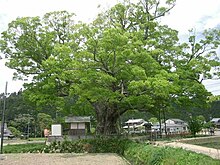Elm family
| Elm family | ||||||||||||
|---|---|---|---|---|---|---|---|---|---|---|---|---|

Ulmus laevis in autumn |
||||||||||||
| Systematics | ||||||||||||
|
||||||||||||
| Scientific name | ||||||||||||
| Ulmaceae | ||||||||||||
| Mirb. |
The elm family (Ulmaceae) are a family in the order of the rose-like (Rosales) within the flowering plants (Magnoliopsida). The approximately seven genera and approximately 35 species are mainly distributed in the northern hemisphere . Some species are used as ornamental plants and some use wood .
Description and ecology

Appearance and leaves
They are rarely evergreen or mostly deciduous, mostly trees , rarely bushes . The alternate and usually two-line arranged on the branches, stalked leaves have an asymmetrical leaf blade at the base with a strongly serrated leaf edge. Stipules are present.
Inflorescences, flowers and fruits
The flowers stand individually or in several groups in differently structured inflorescences. The flowers are hermaphroditic or unisexual. There are (two to) five (to nine) free bracts . The (two to) four to eight (to fifteen) fertile stamens are free from each other. Usually two, rarely three carpels are a top permanent ovary grown. The pollination is carried by the wind ( anemophily ).
The winged nut fruits , also called wing nuts or samara, are split fruits , whereby the ovary consists of two carpels that separate when the fruit ripens. The diaspores spread through the wind:
distribution
The species have their areas mainly in the moderate latitudes of the northern hemisphere .
In Central Europe, especially coming elm ( Ulmus glabra ), elm ( Ulmus laevis ), field elm ( Ulmus minor ) and English elm ( Ulmus procera ) in front, the latter mainly in France and the UK.


Systematics
The family name Ulmaceae was published in 1815 by Charles François Brisseau de Mirbel in Elémens do Physiologie Végétale et de Botanique , 2, p. 905. The type genus is Ulmus L.
For a long time, the Ulmaceae family consisted only of the two subfamilies Celtidoideae and Ulmoideae within one order Urticales. Molecular genetic studies showed that the six or seven families and 2600 species of the earlier order Urticales also belong to the order Rosales . It turned out that the subfamily Celtidoideae with the genera Aphananthe , Celtis , Gironniera , Pteroceltis and Trema are not closely related to the subfamily Ulmoideae. Instead of the Ulmaceae, the genera of the Celtidoideae belong to the Cannabaceae.
Related families within the order Rosales:
| Rosales |
|
||||||||||||||||||||||||
|
|
In the Ulmaceae family today there are only seven genera with around 35 species :
- Ampelocera Klotzsch : The at least three types are common in the Neotropic .
- Hemiptelea Planch. : It contains only one type:
- Holoptelea Planch. : The roughly two species are common in tropical Africa .
-
Phyllostylon Capan. ex Benth. & Hook. f. : The roughly two types are common in the Neotropics.
- Phyllostylon rhamnoides (J.Poiss.) Taub. : Central America, southern Mexico, the Caribbean, Venezuela, Colombia, central to eastern Brazil to Bolivia, Argentina and Paraguay
-
Planera J.F. Gmelin : It contains only one species:
- Planera aquatica J.F.Gmelin : The home is the southeastern USA and it supplies the "false sandalwood".
- Elms ( Ulmus L. ): The 20 to 30 species are mainly native to the temperate zones of the northern hemisphere: Eurasia and North America to Mexico. In China alone, 21 species occur, 14 of them only there. Its fruits are samara, with the seed in the center of the wing. The wood is used, mainly for the production of veneer .
- Zelkoven ( Zelkova Spach ): The five to seven species are native to southern Europe and southwestern and eastern Asia.
swell
- The Ulmaceae family according to the current system on the AP website. (Section description and systematics)
- Kenneth J. Sytsma, Jeffery Morawetz, J. Chris Pires, Molly Nepokroeff, Elena Conti, Michelle Zjhra, Jocelyn C. Hall & Mark W. Chase: Urticalean rosids: circumscription, rosid ancestry, and phylogenetics based on rbcL, trnL-F, and ndhF sequences. , in American Journal of Botany , 2002, 89, pp. 1531-1546: Online.
Individual evidence
- ^ SJ Wiegrefe, KJ Sytsma & RP Guries: The Ulmaceae, one family or two? Evidence from chloroplast DNA restriction site mapping , In: Plant Systematics and Evolution , 210, 1998, pp. 249-270.
- ↑ KK Ueda & Kosuge H. Tobe: A molecular phylogeny of Celtidaceae and Ulmaceae (Urticales) based on rbcL nucleotide sequences. in Journal of Plant Research , 110, 1997, pp. 171-178.
- ↑ Kenneth J. Sytsma, Jeffery Morawetz, J. Chris Pires, Molly Nepokroeff, Elena Conti, Michelle Zjhra, Jocelyn C. Hall & Mark W. Chase: Urticalean rosids: circumscription, rosid ancestry, and phylogenetics based on rbcL, trnL-F , and ndhF sequences. , In American Journal of Botany , 2002, 89, pp. 1531-1546: Online.
- ↑ Ulmaceae in the Germplasm Resources Information Network (GRIN), USDA , ARS , National Genetic Resources Program. National Germplasm Resources Laboratory, Beltsville, Maryland.
Web links
- The Ulmaceae family at DELTA's old size. (English)
- Susan L. Sherman-Broyles, William T. Barker & Leila M. Schulz: The Ulamaceae Family according to ancient dimensions in the Flora of North America , Volume 3. (English)
- Liguo Fu, Yiqun Xin & Alan Whittemore: The Ulamaceae Family by Ancient Extent in the Flora of China , Volume 5. (English)
